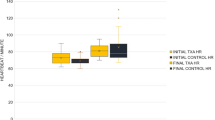Abstract
Background
Plastic surgery patients frequently request extensive liposuction on approximately 30 % of the total body surface area, which indicates that the total dose of lidocaine used might exceed the recommended level. Our previous study demonstrated that the risk of toxicity is low because the peak lidocaine level is below the toxic threshold (3 μg/mL). However, monoethylglycinexylidide (MEGX), the active metabolite of lidocaine, has not been measured in extensive liposuction operations.
Methods
Ten female patients who requested extensive liposuction were enrolled in this study. The targeted areas were divided into two segments and treated in turn for one session. Serum levels of lidocaine and MEGX were taken every 4 h during the first 24 h after the second infiltration.
Results
The peak lidocaine levels (1.94 ± 0.4 μg/mL) were observed after 12–20 h (16.8 ± 2.53 h), whereas the peak MEGX levels (0.67 ± 0.12 μg/mL) were observed after 16–20 h (17.6 ± 2.07 h). The peak concentrations of lidocaine plus MEGX (2.58 ± 0.47 μg/mL) were observed after 17.2 ± 2.4 h.
Conclusions
This study demonstrated that the risk of MEGX toxicity was as low as that of lidocaine toxicity in extensive liposuction operations.
Level of Evidence: Level IV, risk / prognostic study.

Similar content being viewed by others
References
Klein JA (1990) Tumescent technique for regional anesthesia permits lidocaine doses of 35 mg/kg for liposuction. J Dermatol Surg Oncol 16:248–263
Wang G, Cao WG, Li SL, Liu LN, Jiang ZH (2015) Safe extensive tumescent liposuction with segmental infiltration of lower concentration lidocaine under monitored anesthesia care. Ann Plast Surg 74:6–11
Bargetzi MJ, Aoyama T, Gonzalez FJ, Meyer UA (1989) Lidocaine metabolism in human liver microsomes by cytochrome P450IIIA4. Clin Pharmacol Ther 46:521–527
Drayer DE, Lorenzo B, Werns S, Reidenberg MM (1983) Plasma levels, protein binding, and elimination data of lidocaine and active metabolites in cardiac patients of various ages. Clin Pharmacol Ther 34:14–22
Rygnestad T, Brevik BK, Samdal F (1999) Plasma concentrations of lidocaine and alpha1-acid glycoprotein during and after breast augmentation. Plast Reconstr Surg 103:1267–1272
Kenkel JM, Lipschitz AH, Shepherd G, Armstrong VW, Streit F, Oellerich M et al (2004) Pharmacokinetics and safety of lidocaine and monoethylglycinexylidide in liposuction: a microdialysis study. Plast Reconstr Surg 114:516–524
Klein JA (1993) Tumescent technique for local anesthesia improves safety in large volume liposuction. Plast Reconstr Surg 92:1085–1098
Ostad A, Kageyama N, Moy RL (1996) Tumescent anesthesia with a lidocaine dose of 55 mg/kg is safe for liposuction. Dermatol Surg 22:921–927
Oba H (2003) Large-volume tumescent anesthesia for extensive liposuction in oriental patients: lidocaine toxicity and its safe dose level. Plast Reconstr Surg 111:945–946
Nordström H, Stånge K (2005) Plasma lidocaine levels and risks after liposuction with tumescent anaesthesia. Acta Anaesthesiol Scand 49:1487–1490
Habbema L (2009) Safety of liposuction using exclusively tumescent local anesthesia in 3,240 consecutive cases. Dermatol Surg 35:1728–1735
Starling J III, Thosani MK, Coldiron BM (2012) Determining the safety of office based surgery: what 10 years of Florida data and 6 years of Alabama date reveal. Dermatol Surg 38:171–177
Habbema L (2010) Efficacy of tumescent local anesthesia with variable lidocaine concentration in 3430 consecutive cases of liposuction. J Am Acad Dermatol 62:988–994
Lillis PJ (1988) Liposuction surgery under local anesthesia: limited blood loss and minimal lidocaine absorption. J Dermatol Surg Oncol 14:1145–1148
Hanke CW, Bernstein G, Bullock S (1995) Safety of tumescent liposuction in 15,336 patients: national survey results. Dermatol Surg 21:459–62
Commons GW, Halperin B, Chang CC (2001) Large-volume liposuction: a review of 631 consecutive cases over 12 years. Plast Reconstr Surg 108:1753–1763
Klein JA, Kassarjdian N (1997) Lidocaine toxicity with tumescent liposuction. A case report of probable drug interactions. Dermatol Surg 23:1169–74
Inomata S, Nagashima A, Osaka Y, Kazama T, Tanaka E, Sato S et al (2003) Propofol inhibits lidocaine metabolism in human and rat liver microsomes. J Anesth 17:246–250
Nagashima A, Tanaka E, Inomata S, Honda K, Misawa S (2005) A study of the in vitro interaction between lidocaine and premedications using human liver microsomes. J Clin Pharm Ther 30:185–188
Rohrich RJ, Leedy JE, Swamy R, Brown SA, Coleman J (2006) Fluid resuscitation in liposuction: a retrospective review of 89 consecutive patients. Plast Reconstr Surg 117:431–435
Acknowledgments
The authors thank Wei-gang Cao, M.D., Ph.D., Department of Reconstructive and Plastic surgery in Shanghai Ninth Peoples’ Hospital in performing extensive liposuction. The authors thank Li Sun, Ph.D., Department of Pharmacy in Shanghai Renji Hospital in calibrating lidocaine and MEGX measurements in the plasma.
Author information
Authors and Affiliations
Corresponding author
Ethics declarations
Ethical standards
All procedures performed in studies involving human participants were in accordance with the ethical standards of the Shanghai Renji hospital and with the 1964 Helsinki declaration and its later amendments or comparable ethical standards.
Fundings
The creation of this article was not supported by any outside funds.
Conflict of interest
Gang Wang and Zhen-zhou He declare that they have no conflict of interest.
Patient consent
Patient provided written consent prior their inclusion in this study.
Rights and permissions
About this article
Cite this article
Wang, G., He, Zz. Systemic exposure to monoethylglycinexylidide in extensive tumescent liposuction. Eur J Plast Surg 39, 197–200 (2016). https://doi.org/10.1007/s00238-015-1166-2
Received:
Accepted:
Published:
Issue Date:
DOI: https://doi.org/10.1007/s00238-015-1166-2




